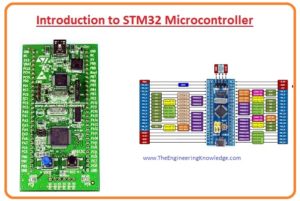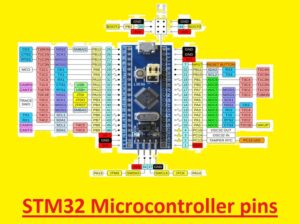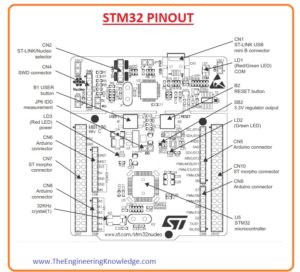 Hello, friends welcome to another interesting post. In today’s post, we will have a detailed look at the Introduction to STM32 Microcontroller. This type of microcontroller belongs to the thirty-two-bit microcontroller ICs created by STMicroelectronics (which is a French Italian multinational electronic producer whose head office is located in Geneva). The most commonly used series of STM32 are Cortex-M7F, cortex-M33F, CortxM3, etc all these have the same thirty-two-bit ARM processor core.
Hello, friends welcome to another interesting post. In today’s post, we will have a detailed look at the Introduction to STM32 Microcontroller. This type of microcontroller belongs to the thirty-two-bit microcontroller ICs created by STMicroelectronics (which is a French Italian multinational electronic producer whose head office is located in Geneva). The most commonly used series of STM32 are Cortex-M7F, cortex-M33F, CortxM3, etc all these have the same thirty-two-bit ARM processor core.
In the interior structure of these microcontroller processor cores, static RAM and flash memory are assembled with some other devices. In today’s post, we will have a detailed look at its working applications, pinouts, and some other related parameters. So let’s get started with Introduction to STM32 Microcontroller.
Introduction to STM32 Microcontroller
- The STM32 is a very common type of microcontroller used in numerous types of devices. It also provides facilities for linking with other types of microcontrollers.
- The STM32 series of MCUS which was created by STMicroelectronics consists of an ARM Cortex-M thirty-two-bit processor core.
- In this microcontroller series and parallel communication system exit through which numerous external devices such as cameras, sensors, motors, etc can be connected.
- Every STM32 MCU also consists of inner flash memory and random access memory.
- The operation range offered by the STM32 is a little bit costly. There are subseries of STM32 like STM32F0 and STM32f1 which operate with the clock signal of having a frequency twenty-four megahertz and exits in a casing having sixteen pinouts.
- Another category of STM32 series is STM32H7 which works at the four hundred megahertz frequency and exits in a casing having two forty pinouts.
- There are some types of STM32 exits which used are exists with the floating-point unit or FPU and are used in high-level numerical processing applications.
- These modern categories of MCU have some features of microprocessors with the microcontroller.
- For such applications that operate on less power or are portable devices, STM32L series is created.
Features of STM32
- These are some features of STM32 which are described here in detail.
- In this module flash memory, up to one megabyte is used.
- An OTP of five hundred and twelve is used in this module.
- Static random access memory of one twenty-eight byte is used in these modules.
- To provide support to the flash memory static RAM PSRAM flexible static memory controller is used.
- Its operating voltage is from 1.8 volts to 3.6 volts.
- The crystal oscillator of four to twenty-six megahertz is used in this module.
- It has an inner sixteen megahertz factory-trimmed RC.
- It uses a thirty-two-kilo hertz oscillator for RTC (Real-Time Clock).
- It has an inner thirty-two kilohertz RC after calibration.
- The modes which it has are sleep stop and standby modes.
- The battery is used to provide back to the RTC, 20 by 32 backup registers, and four kilobytes of static ram.
- This module consists of 3 by 12-bit o. 5-microsecond analog to digital converter having twenty-four channels.
- It consists of 12 sixteen-bit and 2 thirty bits timers.
- It comprises of one thirty-six inputs and outputs having a frequency of sixty hertz.
- It has one thirty-eight input and outputs operating at five volts
- This module consists of 3 I2c interfacings.
- It has 4 USART and 2 UART and 3 SPI.
Difference between STM32 microcontroller and 51 microcontroller
51 microcontroller is used collective name for all controllers that support the ntel8031 instruction system.
The older modules controller series is Intel’s 8031 microcontroller, with advancements in flash ROM technology, The 8031 Single-chip controller is made with the latest features and mostly uses 8bit One of the single-chip microcomputers, with equivalent mode isAT89 series of ATMEL company.
STM32 microcontroller is a 32-bit series controller made by St with the use of cortex -M3 of arms company as the core. its inner design like registers and peripheral functions are higher than 8051, AVR and PIC.
It is close to the CPU of a computer and best for mobile phones, routers,
Disadvantages of 51 MCU
- Some functions like AD and EEPROM needed expansion that caused overburden for hardware and software.
- Though input and output pins can easily be used but not have output support for high levels, which is a drawback of 51 series single-chip microcomputer.
- Working speed, especially double data pointer is slow. So needed improvement for good working.
- its protection feature is also not good and can burn the chip.
stm32 vs esp32
| Spec | ESP32 | STM32 |
|
Advantages |
||
| Applicable Fields | Best for IoT and cost-effectiveness solutions | it is best to use industries |
| Cost | The overall cost is low | Prices Increasing |
| Arduino Environment Support | Easy to program and open sorucefeatuers | it is little bit difficult to program |
| Built-in Bluetooth and Wi-Fi | Bluetooth and Wi-Fi built-in feature | – |
| Dual-core Processor | Compatible with real-time multi-threaded processing | – |
| High-speed Main Frequency | Frequency speed is 240MHz | – |
| Hardware Debugging | it can easily debug | Debugging cost is high |
|
Disadvantages |
||
| Limited Number of Pins | it has fewer pinouts so not used for projects where larger pins needed | |
| Complex Debugging Tool Chain | Complex | – |
| Compilation Process | slower compilation speed | Effective but high-cost |
| Debugging Complexity | difficult debugging and software breakpoint limitations | Simpler debugging but costly |
| burning and compiling is good | ||
STM32 Microcontroller PINOUT
- The main pinouts of the STM32 microcontroller are described here with detail.
CN6
- It is a power supply pinout at this pinout 3.3 volts are provided.
RESET PIN
- This pinout is used to reset the microcontroller.
+3.3 volts pin
- From this pinout, 3.3 volts are taken out as output and used to provide power microcontroller.
+5 volt
- It is a five-volt output pinout.
GND
- It is ground pinout.
CN5
- it is a combination of pinouts D8 to D15 these are digital pinouts and used for SPI.
D13, D12. D11 and D10 Pinouts
- These pinouts operate as serial clocks, master in slave out, master out slave in, and SC pinouts for SPI (Serial Peripheral Interface) transmission.
CN9
- These are digital pinouts and are comprised of D0 to D7 pins.
D0 and D1
- These 2 pinouts operate as receivers and transmitters for USART (Universal Synchronous Asynchronous Receiver Transmitter) transmission.
CN7
- These are digital port C pinouts and comprise of PC0, PC1, PC2, PC3, PC10, PC11, PC12, PC13, PC14, PC15.
PD2
- It is port D input-output pinouts.
PA0, PA1, PA4, PA13, PA14, PA15 pinouts
- These are pinouts of port A.
PB7, PB8, and PB9
- These are pinouts of port B.
PH0 and PH1
- These are pinouts of port H.
Applications of STM32 Microcontroller
- These are some common applications of STM32.
- It is used in less power using handheld devices.
- It is used in different types of robots.
- It uses an automation system.
STM32: Equivalents/Alternatives
- GD32 Series
- Nuvoton (NuMicro) Series
- Microchip PIC32 Series
- Silicon Labs EFM32 Series
- Texas Instruments MSP430 Series
What are the special features of STM32?
- Robust Architecture.
- Scalability:
- Rich Peripheral Set:
- Real-Time Capabilities:
- Energy Efficiency:
- Comprehensive Development Ecosystem:
- Security Features:
- Long-Term Availability:
Which software is used for STM32?
- STM32CubeProgrammer (STM32CubeProg) best multi-OS software tool for programming STM32 products.
How to use STM32?
- Make new projects in STM32CubeIDE.
- in the Target Selection Tool, choose the best microcontroller or Evaluation Board.
- Assign the project a name.
- in the Device Configuration Tool start all the necessary peripherals.
- Make project.
- complete this project with code.
So that is a detailed post about STM32 if you have any further queries ask in the comments, Thanks for reading. Have a good day.








